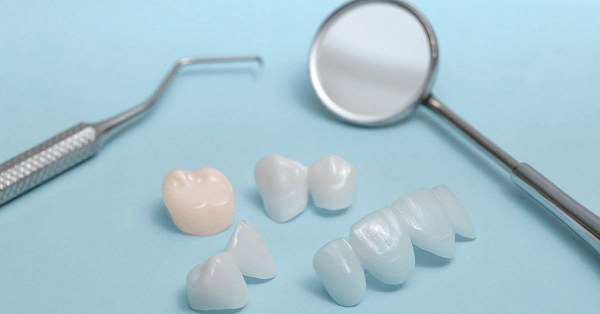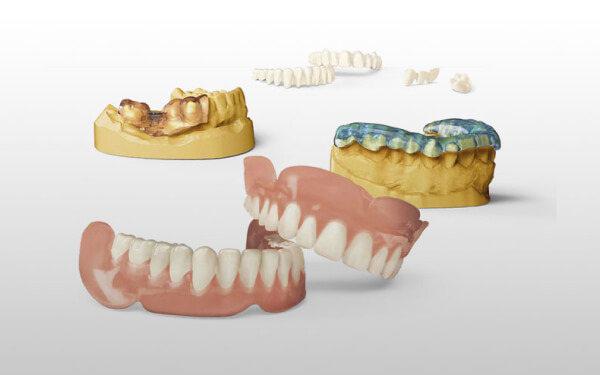Weak restorations, poor fighting, and delays in treatment are the common challenges dentists face when using 3D printers. Multiple reasons cause these issues to arise. However, the main reasons for these problems are low-quality and incompatible materials.
If a material doesn’t work well with the printer, the printed parts may not fit right. As a result, some parts of dental models may look fine, but others could have defects. So, which material is best to achieve flawless results during the creation of crowns and implants? This article provides you with comprehensive details about 3D printing dental material types, benefits, and costs that enable you to choose wisely.
What Is 3D Printing Dental Material?
3D printing materials are used in 3D printers to make dental models. There are different types of materials used in 3D printers. These materials are non-reactive, safe, and compatible with printers.
The basic function of these materials is to make custom-size crowns, veneers, bridges, and implants. Due to the strong and robust nature of the materials, the dental models are built to be accurate. These reduce the risk of adjustment and improve the result’s efficiency.

5 Top Materials Used in 3D Printing for Dentistry
Here are the details of the material the dentist used in the 3D Printers, along with its composition and specifications.
1. Resin-Based Materials
High-strength dental 3D printing resins are made from liquid plastic. These materials harden when exposed to light or heat. Dentists are commonly used in dental 3D printing because they can make detailed dental models.
Dentists use these materials to make:
- Custom-fit dental crowns
- Inlays and Onlays
- Full or partially full set of dentures
Features of Resin-Based Materials:
- Easy to Mold: Dentists need material that is easy to mold without any special equipment. These materials are easily shaped into custom dental pieces.
- Smooth Finish: Once printed, resin surfaces are smooth. It provides a natural look and comfortable feel for patients. This is important for both aesthetics and comfort.
- Fast Setting: Resin hardens quickly when exposed to UV light. So it speeds up the production of dental restorations and reduces wait times for patients.
2. Ceramic Materials
The second material that is widely used in 3D printers is ceramic. This material is made from a mix of clay, silica, and other minerals. They are becoming valued in dentistry for their ability to look like natural teeth.
You can use these 3D printing materials for dental clinics to make:
- Custom size implants
- Veneers to cover front teeth
- Strong and reliable crowns
Features of Ceramic Materials:
- Strong and Durable: Ceramics are highly durable and resistant to wear. This material is a great option for long-lasting dental restorations.
- Biocompatible: Ceramic is safe for use in the mouth. It won’t cause irritation or allergic reactions and will ensure the patient’s safety.
- Wear Resistance: This material is resistant to wear and tear over time. It’s ideal to make crowns and bridges that need to withstand chewing pressure.

3. Metal Materials
This type of material is made of metal alloys. Titanium, cobalt-chrome and stainless steel are commonly used in metal alloys. These materials are known for their strength, durability, and long-lasting properties.
In a dental lab, you can make:
- Strong partial dentures that won’t damage
- Dental implants
- Custom-fit bridges
Features of Metal Materials:
- Highly Durable: Metals like titanium are strong and can withstand the wear and tear of daily use. This makes them ideal for long-lasting dental applications.
- Corrosion-Resistant: Metals like titanium do not rust or corrode. It ensures the models remain stable and safe for use in the mouth.
- Biocompatible: Materials like titanium integrate well with the bone. It is safe and reliable for implants that fuse naturally with the body.
4. Biocompatible Polymers
Biocompatible polymer materials made from acrylic, polyethylene, and nylon. These materials are safe for use inside the human body. It provides the strength needed for dental applications.
In your dental clinic, you can make:
- Temporary crowns
- Lightweight dentures
- Surgical guide
- Splints
Features of Biocompatible Polymers:
- Body-Safe: These polymers are designed to be safe and non-toxic in the mouth. It reduces the risk of irritation or allergic reactions.
- Lightweight: Polymers are much lighter than other materials. You can make dental restorations more comfortable for patients.
- Flexible: Biocompatible polymers can bend without breaking. It provides a comfortable and adaptable fit for dentures.

5. Composite Materials
Composite materials are a mixture of resins, glass, or ceramic particles. These materials provide strength, flexibility, and aesthetic appeal.
Dentists use this material to make:
- Composite filling
- Partial bridges
- Inlays and outlays
Features of Composite Materials:
- Strong and Flexible: This material is strong and able to bend without breaking. This flexibility is a matter in many dental applications.
- Natural Appearance: Composite materials resemble the natural colour of teeth. It provides excellent aesthetic results and enhances patient smiles.
- Versatile: Composites are used in a wide range of dental applications. You can make fillings for crowns without compromising the quality of the models.
What are the Benefits of 3D Printing Dental Materials?
Using the right material in the 3D printer provides a lot of perks for both patients and dentists.
- Reduces Adjustments: The reliable material enables the dentist to create custom-size models. You don’t have to spend extra time refining the fit, which saves your effort.
- Lower Labour Costs: The need for manual labour is reduced. The material enables you to create complex dental models with minimal human intervention. This helps dental practices save money on labour costs.
- Less Invasive: The material’s flexibility and reliability often lead to less invasive Dental Treatments. With better-fitting dental pieces, there is less need for adjustments

What is the Cost of 3D Printing Dental Materials?
The costs of different dental materials are different due to the material composition and specifications. Each material has its advantages and limits. Ceramic materials are strong and available between $50 and $150 per unit.
Metal base materials are durable, and their cost depends on the nature of metal alloys. Generally, $60 to $85 per kilogram is the average cost of this material.
Furthermore, the high-strength dental 3D printing resin’s base material produces detailed and precise models. Typically, $100 – $200 per kilogram is the average cost of this material available in the market.
For biocompatible polymers, you need to invest more. In the market, the $50 to $250 per litre is the average cost of the material. Well, for the composite material, the average cost is between $20 and $50 per syringe.
FAQS
What materials are used in 3D printing dentistry?
In dental labs, dentists commonly use light-cured resin in 3D printers to make dental crowns, bridges, veneers, and implants. This material is lightweight and biocompatible. The patient won’t face any allergic reaction and will feel comfortable.
What is the best material for artificial teeth?
Mostly porcelain and acrylic materials are used to make artificial teeth. These materials provide reliability and durability. So, the dental models won’t degrade over time and enhance aesthetic appeal.
Is 3D printing expensive?
Generally, the 3D printing models cost anywhere from $20 to $200. It means the models of 3D printers are not as expensive as people think. However, the volume and complexity of the model and the dentist’s experience impact the patient’s budget.
Final Thoughts
To sum up, there are different types of 3D printing dental materials. Each material has its own benefits, specifications, and features. Which material is best for your dental lab?
I think it depends on your budget, your experience level, and your budget. It’s important to choose the brand that provides high-quality materials without breaking the bank. Aidite provides quality and affordable dental materials and equipment with biocompatibility features. You can make different dental models and improve patient experience levels.



